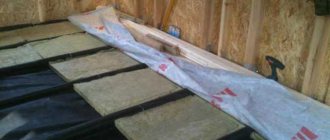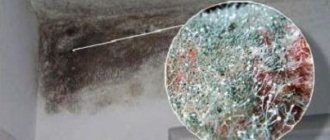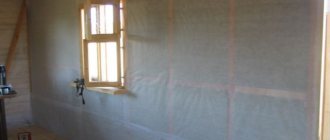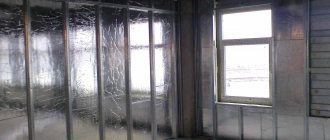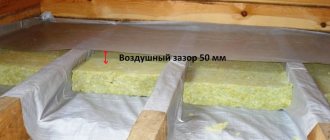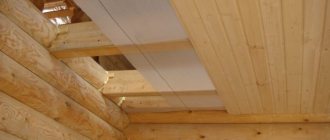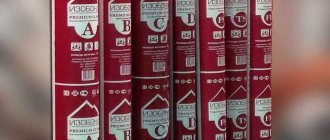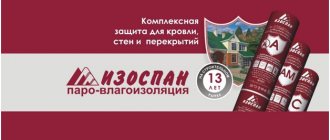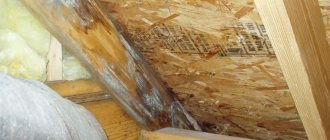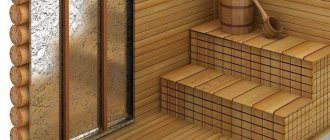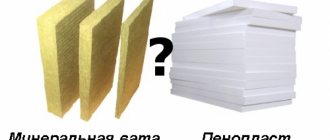Izospan membrane insulating sheets, used to block water vapor, enjoy a well-deserved reputation as reliable and effective vapor barriers. The only thing you need is to correctly lay Izospan against the wall with the side that has maximum vapor permeability. The front and back sides of the panel are similar to each other, so the manufacturer usually marks both sides so as not to make mistakes when laying. But it’s better to read the instructions for installing Izospan on walls. Because in different situations, the installation scheme inside and outside the house may differ.
Laying the membrane on the inside in a vertical row
Why do you need Izospan for walls?
In almost any scheme for insulating a wall surface, the material must be laid in sheets or panels. With the exception of ecowool and polyurethane foam sprayed onto the walls. It is clear that, no matter how hard the master tries to tightly lay sections of thermal insulation on the wall, there are still joints, seams and points for attaching sheets. In these same places, water vapor actively penetrates into the thickness of the insulation, which subsequently condenses and forms cold bridges. In addition, almost all types of thermal insulation, except for EPS, have a certain level of vapor permeability, which is why moisture accumulates in the thickness of the walls and the process of degradation of the insulation begins. Therefore, insulation must be installed with parallel laying of Izospan or materials similar in characteristics to it on the walls.
In general, wall cladding with Izospan, depending on the brand of canvas, provides:
- Protecting the wall from the penetration of water vapor into wooden parts and into the thermal insulation layer;
- Waterproofing when laying on the outer surface of walls;
- Insulation when laid in several layers.
In fact, under the Izospan brand, several types of insulation are produced based on polypropylene film and non-woven fabric, structured polyethylene fabric with a film base and fiberglass.
For your information! Structurally, Izospan is a kind of sandwich of several types of materials with different properties. Therefore, regardless of the brand, it always matters which side is the correct way to lay isospan on the walls. Otherwise, you can get the completely opposite effect.
Some types of membranes are capable of transmitting only warm water vapor, but are less resistant to supercooled moist air and liquid moisture. In this case, Izospan can be laid and used as insulation for walls, but cannot be used for waterproofing. Other brands, for example, Izospan B, are completely vapor-tight and highly resistant to water pressure. Therefore, in any case, before use, you need to study the material, determine which side is the front side and which is the supporting side. The manufacturer always indicates on the packaging the side markings, the composition of the material, and even indicates on the panel the markings of the overlap lines when laying on the walls.
Vapor barrier for the walls of a frame house, insulation is laid from the inside of the room
Characteristics and differences
Izospan is a non-woven building material. It is produced in the form of films and membranes, which are designed to protect and insulate surfaces. Izospan goes on sale in rolls.
Materials are divided into three groups:
- Windproof. This includes all insulators marked with the letter A. They are needed to retain internal heat and prevent winds from blowing through the insulation. The material does not allow moisture to pass through, but is capable of removing evaporation.
- Fully waterproofing. They are marked with the letters B, C, D. And they do not allow water or evaporation to pass through.
- Energy saving. They are marked with the letter F. They have the same characteristics as the previous group, but have a metallized reflective layer.
From the above it can be understood that only the first group has the ability to pass steam. It is precisely this that should be used to insulate residential premises, since all living organisms emit fumes into the atmosphere. And if the liquid in the form of steam is not able to leave the room, then the humidity in it will soon rise critically.
Types of vapor barrier Source stroychik.ru
The remaining groups are solid insulators. But the latter has a thin metal coating that can reflect heat, preventing it from leaving the room. This feature requires an air gap between the mirror layer and the other material. It must be at least 3.5 cm.
And before you think about how to properly lay Izospan, you need to fully study the brand on the product. The first letter on the marking is often followed by others. They indicate additional insulation properties. For example, the letters M or S indicate the presence of reinforcement. And the abbreviation of small letters “fix” indicates the presence of applied strips of glue along the edges. And when buying such a product, you don’t have to worry about tape.
Which Izospan to use for walls outside and inside the house
The range of vapor-waterproofing membranes includes more than two dozen types of materials, each of which has an individual structure and is used to solve specific problems.
In simplified terms, the purpose of membranes can be described as follows:
- Hydro- and windproof vapor-permeable materials. Izospan “A”, “AM” are used for external protection of the walls of the house, AQ, AS membranes are used to protect the roof from the accumulation of condensate. According to the instructions for using Izospan A for walls, the protective fabric blocks air convection through the insulation, while at the same time having high strength to withstand mechanical loads due to gusts of wind;
- Membranes of grade “D” are used as a vapor barrier and to protect insulation and load-bearing structures; they are laid on the wall from the inside of the building. Can be used to protect against under-roof condensation; the standard use of Izospan D is laying on walls and covering the ceiling from inside the building;
- Brand “B” canvas is used to protect against falling condensation on wooden walls and ceilings from inside the room. The material is impervious to steam and condensation, therefore Izospan is recommended for interior decoration of the walls of a frame house.
Brand “A” membranes are a polypropylene fiber structure that easily allows air to pass through, but blocks the movement of vapors. The denser AM fabric is reinforced on both sides with a polypropylene lining made of non-woven material. Izospan is recommended for walls outside a wooden house when laid on top of mineral wool-based insulation.
Izospan grade “B” is a two-layer material based on film and polypropylene fabric. It is easy to distinguish by the appearance of the sides: one of them is smooth and is designed to protect against liquid moisture, the second is rough, with anti-condensation properties.
Material grade “D” is a very durable woven polypropylene fabric with pronounced anti-condensation surface properties. A protective coating on the surface of the polypropylene membrane prevents supercooled water vapor from condensing. Due to special impregnation, any moisture that gets on the surface of the wall does not wet the canvas, but automatically rolls down.
Which Izospan should I use for bath walls?
For the steam room, reflective vapor barrier of the “FB” brand is used. Essentially, it is thick craft paper with a metallized Mylar film applied on one side. The paper can withstand prolonged heating up to 140°C without burning or destruction of the structure. Laying on the walls is carried out with a metallized surface inside the room.
The outer walls of the bathhouse are lined with Izospan A. Inside the room, especially if thermal insulation based on mineral wool was used in the walls, it will be necessary to line it with a vapor barrier of grade “B”.
What is Izospan?
According to their intended purpose, all Izospan materials are divided into four categories:
- Waterproofing membranes. Used in insulated and non-insulated pitched roofs. They protect the insulation and attic from possible leaks and condensation from the inside, which forms on the inside of a cold roof upon contact with warm and humid air. The vapor-permeable properties of the membranes allow moisture to evaporate from the insulation, preserve its thermal insulation properties and do not create conditions for the elements of the supporting roof structure to get wet. Another function is protection against weathering of mineral wool fibers.
Waterproofing is laid under the roof sheathing
- Vapor barrier for the roof. A multilayer film in which one of the sides has an anti-condensation surface. Used in insulated pitched and flat roofs to protect mineral wool from the penetration of vapors with warm air from inside the building. Izospan materials are not an absolute vapor barrier, but they have a high enough resistance to vapor permeation to keep the insulation dry by ventilating moisture from it through the membrane to the outside (into the ventilated under-roof gap). Another function is to protect the attic from mineral wool fibers. Like any vapor barrier, Izospan films have high waterproofing properties (withstands the pressure of a water column with a height of at least 1200 mm), and they are used as moisture insulation for uninsulated roofs.
Vapor barrier, not counting the sheathing, is the outermost layer of the roofing pie
- Reflective vapor barrier. It differs from the usual one by the presence of a metallized outer layer on one side, which reflects some of the heat back into the room. Used in the roofing pie of a heated attic. Allows you to save up to 10% on heating costs.
- Connecting tapes. Used for joining adjacent sheets, extending them in length, connecting waterproofing and vapor barriers with adjacent surfaces, roof and drainage elements.
Connecting tapes are an essential element of hydro- and vapor protection
Which side should Izospan be placed against the wall?
Now the most important thing is to choose the right direction for laying the vapor barrier. Each brand of membrane has its own defining feature, which helps not to confuse the side that needs to be applied to the wall. Most often this is the color or texture of the membrane surface.
In accordance with the instructions for using Izospan A for walls, the membrane is applied with a rough surface to the sheathing or on the insulation. The smooth side should, as they say, “look at the worker.”
Further, according to the instructions for using Izospan AM for walls, the color of the material is used to determine the outer and inner sides. The AM brand membrane has a beige or gray colored fabric on one side and white on the other side. For external wall insulation, Izospan must be mounted on the sheathing with the white or light side facing the thermal insulation. The painted side will be the front.
Izospan “B” in its structure resembles grade “A”, with the only difference being that it is used for arranging a vapor barrier for walls from the inside, from the inside of the room. One side of the membrane is smooth, the other is fleecy. You need to install Izospan B with the smooth side facing the wall.
Vapor barrier grade “D” is used to protect uninsulated walls from exposure to humid and supercooled air. A distinctive aspect of Izospan is its high strength and good waterproofing qualities. One side of the panel is made of woven polypropylene fiber; it is easily recognized by its characteristic surface texture. The second side is smooth, has a laminated coating of polypropylene film. Waterproofing should be installed on walls with the woven side facing inward and the smooth surface facing outward.
Additional recommendations on the location of the Izospan B coating
If you also decide to use Izospan V when carrying out repair work, which side should be placed towards the insulation, it is important to ask before the start of manipulations. For example, if the working surface is plasterboard, then the membrane must be fixed to a galvanized profile. It should be tightly mounted with the smooth side facing the thermal insulation. All resulting joints and places where the membrane will be connected to other materials must be glued with connecting tape from the same manufacturer. Do not forget to leave a ventilation gap of 3 cm, which is necessary to prevent the dew point from shifting and reduce the likelihood of excess moisture accumulation.
Quite often, people wonder which side to place the vapor barrier against the insulation, if the latter is reinforced on the outside of the wall. In this case, “Izospan B” should be installed indoors, and its rough part should face inward. To fasten the material in all cases, you can use a stapler or slats, the latter of which are nailed. Both solutions are good, the main thing is to purchase galvanized fasteners, which will last a long time and will not cause rust spots.
How to properly install Izospan on walls
In most cases, the material is attached to the wall to the slats using a regular construction stapler. It makes no sense to use any additional plastic spacers, since the polypropylene woven base can easily withstand quite large mechanical loads.
If you plan to use Izospan when insulating walls according to a scheme with a ventilated facade, then the material is fixed in the following ways:
- Roll out onto the lathing with double-sided tape laid on top, after gluing on the overlap line, the panel is fixed with staples;
- The membrane is rolled out, simultaneously stretched and nailed through wooden slats.
The choice of method depends on the structure of the walls, the quality of the lathing, the presence of insulation and the type of decorative finishing.
Laying the membrane horizontally
What tools and materials will be needed
To install vapor barrier you will need a minimum set of tools and equipment:
- Cutting knife;
- Bench's ruler and tape measure;
- Construction stapler.
Consumable materials will need to be purchased: nails, staples, wooden slats and adhesive connecting tape of the “KL” brand.
Preparing the walls
There are no special requirements for preparatory work before laying vapor barrier. If you plan to lay the canvas on a wooden sheathing, you will need to check the surface for protruding chips and chips, or any defects that could damage the membrane.
In other cases, it is enough to clean and remove dirt from the walls. Otherwise, the ability of the membrane to transmit steam may be reduced due to clogging of the surface with small debris and dust.
How to properly lay and attach Izospan to the walls
The procedure for installing vapor barriers on lathed walls has long been worked out by material manufacturers and even improved in some ways by builders.
The installation process for Izospan A or D is as follows:
- We check the readiness of the lathing for laying the material, take the dimensions of the walls and calculate the length and number of panels in one roll;
- We roll out the Izospan, choose which side to mount, lay it on the sheathing with an overlap and fix it with a stapler on one side;
- We stretch the fabric and sew it evenly with staples along the wooden bars of the sheathing;
- Roll out the next panel and lay it above the previous one with an overlap of at least 15 cm;
- We lift the lower edge of the new canvas and roll out the sealing adhesive tape, press the edge into place and secure the laid row of Izospan with staplers;
- We cut out the wooden slats of the counter-lattice according to the height of the wall, and nail them into the vapor barrier.
If laying Izospan on the wall is carried out without insulation or is finished with decorative plaster, then before starting work the wooden parts are treated with varnish, laying the panel on the wall is done only with double-sided tape or KL+ tape, with further filing with a stapler.
Izospan A
The material is produced in the form of a diffusion membrane, which is capable of completely retaining any liquid. But evaporation passes through it easily. Therefore, if it is positioned correctly, it serves as reinforcement and protection of thermal insulation. It also does not allow the latter to accumulate moisture from evaporation coming from the room.
Vapor barrier marked A Source roofing façade34.rf
The exception is Izospan A (base). This material serves only as a wind barrier and, in addition to steam, it also allows moisture to pass through. It is used to insulate the ceiling located above the facade, in which there is good air circulation. Place the membrane on top of the mineral wool, on the subfloor side. And it allows the insulation to get rid of not only steam, but also water.
The temperature range for operating the material is quite wide. The insulator can be used from severe frosts of -60 °C to serious heat of +80 °C. Izospan A is able to retain its characteristics even when exposed to ultraviolet radiation. But the truth is only for 3-4 months. Then a sharp decline in performance begins.
The insulator is able to withstand a fairly large tensile load, and some materials even have fire-fighting properties. Based on these parameters, group with the letter A is best used for ventilated facades and frame-type enclosing structures. Also for a roof that has double sheathing and a slope of at least 35 degrees.
Waterproofing for metal tiles Source stoydiz.ru
See also: Catalog of companies that specialize in home insulation
Basic rules for working and instructions on which side to lay Izospan A to the insulation:
- The material on the wall begins to be mounted from below.
- The same sequence must be maintained when working on a pitched roof.
- On horizontal roofs, Izospan is laid starting from any of the walls.
- The next panel must be laid with an overlap on the previous one. Ten centimeters are enough on the walls, and ceilings and roofs should have at least fifteen centimeters.
- If there are no adhesive strips on the edges, then all connections are fixed using double-sided tape.
- For a clearer connection to the rafter system, it is better to use a special sealing tape.
- For material with clear markings (only one letter A), it makes no difference which side the insulator is applied to the insulation.
- Izospan, which has double markings (AS, AM and others), must be unfolded so that the logo is on the outside.
Installation of vapor barrier Source dolgostroi.pro
The last point is very important. If you make a mistake, fumes will begin to accumulate in the insulation. It will get wet, which will lead to the loss of its positive properties. The process will speed up significantly when moisture begins to partially penetrate from the outside as the other side allows steam to pass through. And there is enough vapor everywhere.
How to properly lay Izospan on the walls in a bathhouse
The process of laying a vapor barrier inside a sauna is somewhat different from the technology of laying a membrane inside a living space.
What we pay attention to:
- Initially we lay metallized isospan on the floor, only then on the wall sheathing. The metallized side must be facing towards the room;
- The pitch of the vertical sheathing on the wall for laying the membrane is chosen equal to the width of the roll minus 4 cm. The edges of the panel on both sides should rest on the wood with a slight overlap to the left;
- The overlap between the laid pieces must be sealed with aluminum tape of the Izospan FL termo brand;
- Laying vapor barrier on the ceiling should be done with an overlap of 10-15 cm on the walls.
Accordingly, the fabric laid on the walls of the steam room should overlap the floor insulation by 15-20 cm. There should be no gaps or joints not taped, otherwise the steam from the back side of the membrane will turn into condensation and accumulate in the thickness of the insulation.
Which side should I place the isospan vapor barrier on the floor on top of the insulation?
1. floor 2. vapor barrier Izospan RS, B, B fix 3. counter lath 4. subfloor 5. beam 6. insulation 7. windproof membrane Izospan A base
When installing a basement floor, it is recommended: 1) install forced drying wooden elements and dry insulation; 2) pay special attention to careful sealing of overlaps and junctions of the vapor barrier; 3) ensure effective ventilation of the underground space; 4) carry out a set of drainage works to ensure effective drainage of water from the foundation.
If you plan to operate the basement floor in conditions of high humidity from the underground side, then for the construction of the basement floor it is necessary to use materials that are not prone to moisture accumulation and are resistant to its effects, i.e., it is not recommended to use a structure using fiber insulation and wooden elements.
Wind protection
In the construction of the basement floor above the ventilated underground, it is recommended to use the windproof membrane Izospan A socle .
Wind protection installation instructions
The windproof membrane Izospan A base is mounted on the floor beams from the underground side (from below), with an overlap (the width of the horizontal and vertical overlaps is 15–20 cm) and is attached to the beams using a construction stapler. The side of laying the material does not matter. Izospan And the base is hemmed from below with subfloor boards.
Vapor barrier
Izospan RS, Izospan B or Izospan B fix as a vapor barrier, as well as to prevent the penetration of insulation particles into the living space .
Installation instructions for vapor barrier
Izospan RS (Izospan B, Izospan B fix) is laid on floor beams above the insulation, with the rough side facing the insulation. The vapor barrier is installed with an overlap (the width of the horizontal and vertical overlaps is 15–20 cm). The material is attached to the floor beams using a construction stapler or galvanized nails with a wide head.
To ensure the tightness of the vapor barrier layer:
1. Overlaps of Izospan RS Izospan KL+ or Izospan ML proff connecting tape . Izospan V vapor barrier sheets must be glued with connecting tape Izospan KL+, Izospan KL, Izospan SL or Izospan ML proff . Horizontal overlaps of the vapor barrier Izospan V fix are glued using adhesive tapes applied to the material sheet, vertical overlaps of Izospan V fix are glued using adhesive tapes Izospan KL+ or Izospan ML proff .
2. Places where vapor barriers meet wooden, concrete and other surfaces must be glued with Izospan ML proff or Izospan KL+ .
It is recommended to create a gap of 4–5 cm between Izospan RS (Izospan B, Izospan B fix) and the finished floor. To do this, antiseptic wooden slats 4x5 cm are mounted on top of the vapor barrier.
Instead of Izospan RS (Izospan B, Izospan B fix), Izospan C or Izospan DM can be used as a vapor barrier in basement structures . Izospan DM is stacked similarly to Izospan RS, Izospan C is stacked similarly to Izospan B.
Izospan RF, Izospan FS, Izospan FD and Izospan FX can also be used as a vapor barrier with an energy-saving effect in the construction of basement floors .
Izospan RF (Izospan FS, Izospan FD, Izospan FX) is laid on floor beams above the insulation, with the metallized surface facing up. The reflective vapor barrier is installed with an overlap ( Izospan FX - end-to-end), the width of the horizontal and vertical overlaps is 15–20 cm. The material is attached to the floor beams using a construction stapler or galvanized nails with a wide head. To ensure the tightness of the vapor barrier layer, the overlaps of the reflective vapor barrier sheets must be glued with metallized connecting tape Izospan FL ; the junctions of the reflective vapor barrier with wooden, concrete and other surfaces must be glued with Izospan ML proff or Izospan KL+ . It is necessary to maintain a gap of 4–5 cm between the reflective surface of Izospan RF (Izospan FS, Izospan FD, Izospan FX) and the finished floor to ensure conditions for thermal reflection. To do this, antiseptic wooden slats 4 × 5 cm are mounted on top of the vapor barrier.
Recommendations and common mistakes
The most serious mistake is considered to be failure to use specialized adhesive tape to seal joints. Failure to use sizing, as well as the use of unsuitable materials - sanitary sealant, paint, all this causes moisture to leak in and the formation of wet spots on the back of the insulation.
It is especially important to use tape when laying Izospan V indoors over mineral wool insulation. On the back side of the film, a large amount of basalt dust is heated, which easily penetrates into the room through the smallest cracks.
Important! The second mistake is the frequent use of nails. Do not rush to nail the counter-lattice until all Izospan panels are laid. Any hastily driven nail can cause the metallized paper to break.
